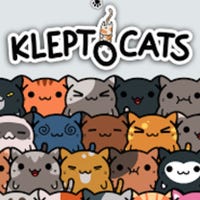
Featured Blog | This community-written post highlights the best of what the game industry has to offer. Read more like it on the Game Developer Blogs or learn how to Submit Your Own Blog Post
KleptoCats Post-mortem
Hello, I’m Antonio Uribe, better known as Fáyer. I’m the Co-founder and Director of HyperBeard Games, an indie game studio based in Mexico City. The following text is a combination of an analysis and the story about the development of KleptoCats.

 Hello, I’m Antonio Uribe, better known as Fáyer. I’m the Co-founder and Director of HyperBeard Games, an indie game studio based in Mexico City. The following text is a combination of an analysis and the story about the development of our mobile game KleptoCats.
Hello, I’m Antonio Uribe, better known as Fáyer. I’m the Co-founder and Director of HyperBeard Games, an indie game studio based in Mexico City. The following text is a combination of an analysis and the story about the development of our mobile game KleptoCats.
HyperBeard before KleptoCats
At the start of the development we weren’t in the best position. We were sad. The office had lost half of its people because the game we made before wasn’t the success we needed financially speaking, and we were a couple months away of losing the other half. All the people involved in the project thought that this was going to be the last game we made together as a team. But well, if you follow us on Twitter you know that we actually made it and we are still making games.
Where did the idea come from?
While working on the game before KleptoCats, we noticed there was a feeling of discontent towards the players of mobile games- that they only wanted free games and didn’t want to pay for quality content. With this in mind Joe and JP made a prototype as social criticism. The idea was the user would send a cat out and it would return with a random object, and the time the user had to wait would increase more and more from seconds to minutes, hours, days, weeks… The only way to make the cat come back quickly was by paying or watching an ad. I liked the concept a lot, because the objects they chose were really interesting and they caught my attention quickly. Unfortunately, The Balloons (the prior project mentioned above which failed financially) was still under development during our exploration and our boss thought the prototype was kind of silly. So, before we got to explore these ideas further we archived the prototype in our “to do” folder.
After The Balloons wasn’t the success we expected, we immediately started to work on other games. Half of the team worked on a shoot ’em up and the other half worked on a pet game with cookie clicker and world building mechanics. The whole future of the studio depended on these games. By January of 2016, only Joe, JP and me were working for the company. The boss visited us to check the progress on the pet game, which we decided had the most chance of success. The game wasn’t close to playable, the ideas were all over the place and nothing was clear. Disappointed with the state of the development he asked us if we had something that could be done before March, the official closing date of the branch. We remembered the cat idea and with a frown on his face he let us make it. After the first iterations, he was super happy with the project. I make him seem like an asshole but really he’s not so bad (he made me add this part).
Throughout HyperBeard’s history we have paused and canceled many games. This never means that the idea dies, only that it is saved for the future. The pet game was canceled at the time, but KleptoCats was influenced by it and from other games paused in the past. Alchademy, for example, took a lot of inspiration from another game that we developed years ago, mixed with a game that we are about to release soon and with the waiting mechanics of KleptoCats.
Development through iteration
In the beginning, the prototype only had the cat, several objects, and the waiting mechanic. We didn’t know where this game was going, we just started working and ideating with what we had. In three to four weeks we implemented 100 cats, 100+ objects, and the first room. We also added other mechanics like feeding, petting, the mini game, and sounds (that we did ourselves with a mic). With that we decided to soft launch in Mexico and Canada to see if people had any interest in a strange game like KleptoCats.
Thanks to that soft launch we learned a lot and found more things that players wanted in the game. In the next two weeks we added music, accessories, the possibility to change the cats’ names, displaying inactive cats in the background, GemDog, the golden cat, and the object’s descriptions. We also gave ourselves the opportunity to experiment with other ideas. We considered giving the players the ability to place the objects in the room as they wanted. We also considered having different types of cats or even other animals. At the end we decided to continue on the path we already had because it made the most sense for the current game and sometimes the benefits of the ideas didn’t make up for the time we needed to invest.
After the experimentation and the soft launch, we launched globally on March 17, 2016 on iOS and Android. We had valuable feature placement in both stores and a lot of people shared screenshots and more in their social networks. We realized even before we launched that players actually liked sharing stuff about the game.
Not everything went super smoothly, the Android feature got us a lot of attention and with that attention we were flooded with 1 star reviews because the game didn’t work on several low end devices. Those reviews put our game below the 4.0 stars threshold and it was dropped out of the feature. Lucky enough, we managed to work on some optimizations and the game returned to a good position. Now it’s a rated a very respectable 4.5.
KleptoCats’ story and fan theories
If you’re a fan of the game, you’ve probably come across some strange objects that seem to suggest that the game is somewhat more complex than it seems. KleptoCats has a story that is developed while collecting objects. Due to the randomness of the order you may collect the objects, some users may discover it sooner or but for others, it may take a while. The object that makes it very obvious that something is strange, is the mirror.
While we were developing the game, JP (the lead artist) had thought it was a good idea to put a mirror in the center of the room and draw someone tied to a chair in the reflection. That was the origin of the back story. The idea is that the character who is tied up in the mirror, IS the “player” in a certain way. That player is also the voice that describes objects and is the one who experiences what happens in the game. Something that makes the mystery more interesting is that the reflection is only seen when the object is placed. It’s not shown in the catalog and its description says “nothing to see here, just a regular mirror.”
From there we developed the story into the game and added many more objects that took the story to another level, ending with the secret codes hidden in each of the first 4 rooms that, when entered into the safe, open a special secret level for really dedicated fans.
Because of this secrecy, and the way it unfolds differently for each person depending on what objects you find, there are many fans who developed theories about what was going on. A simple Google search reveals several videos, images, and posts with theories. On our side, to keep the lore going, we decided to make a comic that gives a bit more information.
The weirdness of an idle mechanic and the mobile game dev scene
KleptoCats is weird on several levels, but the weirdest thing, by far, is the wait mechanics on which the whole game is based. Most game design strategies are meant to keep your players happy and make them play a lot. In our game we try to have them interested a couple of minutes and then let them leave because there is nothing else to do. The game was designed like a small window to a strange world. Although we make money from the little patience that some players have, we always recommend to wait instead of rushing to find everything.
We didn’t invent the waiting mechanic and we were definitely not the first ones to make an idle collection game with cats (there is Neko Atsume). At first we were criticized for having stolen this other game but, if analyzed, the games are very different. Yes, both have cats, collections and idle mechanics, but how they are played and the purpose of each are very different. I think fans knew to differentiate and appreciate each one for its unique ways.
I think the comparisons happened because both are mobile games, an area of the gaming industry that is not well received. Gamers say that mobile games are not real games, the video game press rarely talks about them, and platform users think that we are only interested in money. Mobile game developers never get respect, and the few times a mobile game catches the attention of the world or the press is because it is making a lot of money. Nobody sees mobile games like the games on console or PC.
The mobile market is a complicated platform. Not only do we get little respect in the industry, we also have to find a way to make money in an ecosystem that refuses to pay and is saturated with free high quality options such as Supercell, King and in recent months Nintendo with IPs like Pokémon and Mario. This topic could be explored even further but for now I do not want to get too distracted.
Passing along to other teammates and combatting momentum
HyperBeard is a small team, when we started KleptoCats we were only 3 people, and now we are 7. The project started with Joe (programmer), JP (artist) and me helping with everything else that was necessary. This team developed the game to the third room. From there we hired a couple more people to add more details and eventually take control of the project. Mario, Marms, and Kyu developed the game from the 4th to the 6th room. The 7th (and those that follow) are currently being developed in collaboration with another branch of the company that owns HyperBeard. Even though to our standards KleptoCats was a success, after months of work and trying to do something new, we found trying to continue the project got tiresome. That’s why we decided after months of working, it was a good idea for the original team to move onto other things while the new members could take it and give it a fresh and different vision. After a month with the new core team, we again decided that it was better to take it to other people. We discovered that it is better to cycle development teams so that it does not feel monotonous and that others can adapt part of their tastes and cultures to the game.
For games like KleptoCats content is very important, it ensures that the app stores pay attention to the game and players stick around and invest in it. Even more important than the content is the people who are working on it, you have to maintain a high morale and also keep the interest of the creators for the project. If you get to lose interest the game will suffer the absence of creativity. That’s why we decided to cycle the development.
The Dupes (duplicated objects)
Having a success doesn’t mean that everything we did was perfect. An example at the beginning of development, due to the randomness of the game, there were many complaints from the players because the cats were bringing repeated objects. Although in the game when this happens we give more coins to the user, we wanted to do something so that the player did not feel like it was a mistake.
To correct the issue, we decided to remove the repeated objects and instead show a bag of money, so it would be more obvious that we were giving more coins. It did not work as expected, although internally the game worked the same, many users complained because by only showing the money bag it was much more obvious when the cat was not giving you a new object.
Not long ago we added another feature to the game where we showed a bubble with the description of the object that the cat brings, because of that, we decided that it was a good idea to return the repeated objects so the user could see again the descriptions that are an important part of the game. Again, it backfired, there were many complaints because the cats were bringing repeated objects and many thought it was a bug in the game.
In all iterations about duplicate objects, things worked exactly the same, the changes were only graphical. Either way the fans always reacted in a negative way, which taught us that sometimes it is better not to pay too much attention to what they say and it is better to see how they act on it.
Merchandise
If you follow us on social networks, you’ve probably seen some pictures of the plushies we made of Guapo (the main cat in KleptoCats). By chance we found a local manufacturer that had some cat plushies that looked very similar to ours and we contacted them to do some tests. We liked the results so much that we shared it online and made a mailing list for anyone interested in getting one. In a couple of weeks, we gathered more than 10,000 subscribers and decided to order 100 units to test.
Selling the plushies was not difficult but we never considered how complicated and expensive it is to send the merchandise to other countries, considering that almost all the fans were from outside Mexico. The entire process took a long time and surely that was more expensive than what we recovered when we sold them. Either way, it was not a bad experience and it was worth it just to see fans from various parts of the world with their KleptoCats plushies.
Besides plushies we did other things, too. A friend helped us with a webcomic that illustrates a bit of the lore of KleptoCats. We also made several stickers to distribute in events and to our friends. The KleptoCats page has a paint tool where you can create KleptoCats and we also have a section of wallpapers for phones and PCs.
KleptoCats Today
The game’s birthday is on March 17th. Today the game has 7 rooms, 280 cats, 844 objects, many accessories to dress the kittens, and is translated into 8 languages. We are still working on the game and a new room will be released soon.
From its first day until its birthday the game has been downloaded more than 6 million times and has generated more than $800,000 (53% from IAPs and 47% from ads). In total, all users have played about 8 million hours, which is almost a thousand years.
We are very happy with the success that KleptoCats has had and in addition to putting HyperBeard on the map, it gives us the money to continue chasing crazy ideas. We are currently developing a couple of ideas and we are getting ready to be publishers for projects similar to ours.
If you read the whole post, thank you very much for your time. If you have any questions or comments, you can always go to my twitter (@fire_tony) or HyperBeard’s (@HyperBeard). On the HyperBeard website you can find more information about our other games and the contact information. Please follow our social networks, on there we are always sharing what we do.
Read more about:
Featured BlogsAbout the Author(s)
You May Also Like







.jpeg?width=700&auto=webp&quality=80&disable=upscale)








